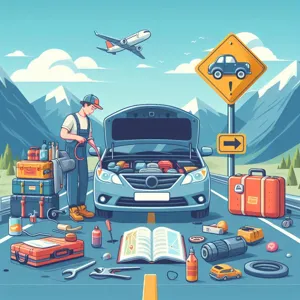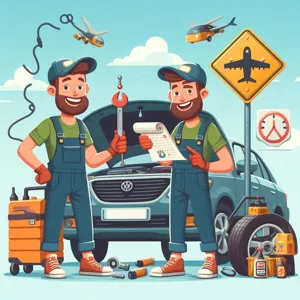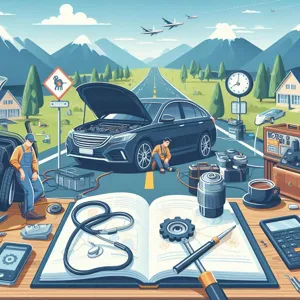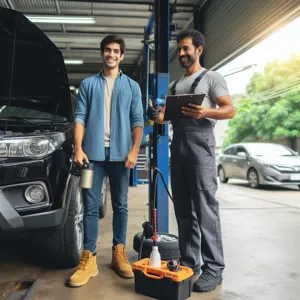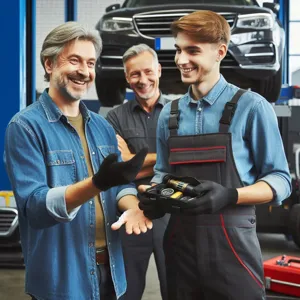In a world forever altered by the pandemic, our vehicles have become more than just modes of transportation; they are our sanctuaries on wheels, serving as safe havens in uncertain times.
As we navigate this new reality, understanding essential car maintenance has never been more crucial. Regular upkeep not only ensures the reliability of our vehicles but also supports our health and safety as we venture out for necessary errands or much-needed getaways. From checking fluid levels to maintaining tire health, the intricacies of vehicle care can be overwhelming, especially when juggling the added complexities of a pandemic. In this comprehensive guide, we’ll delve into the critical aspects of car maintenance that you need to prioritize during these challenging times, empowering you to keep your vehicle in top shape while navigating the road ahead with confidence and peace of mind.
1. Introduction: The Importance of Car Maintenance During a Pandemic

In the ever-evolving landscape of a pandemic world, the importance of car maintenance has taken on new dimensions. As we navigate through uncertain times, our vehicles have become more than just a means of transportation; they are vital lifelines that connect us to our loved ones, essential services, and our daily routines. With public transportation systems facing disruptions and ride-sharing options becoming less reliable, ensuring that your car remains in optimal condition is a necessity rather than a luxury.
Regular car maintenance is crucial not only for the safety and longevity of your vehicle but also for your peace of mind. In a period where health and safety are paramount, knowing that your car is reliable can reduce anxiety and foster a sense of security. Routine checks and services—like oil changes, tire rotations, and brake inspections—help prevent breakdowns that could leave you stranded and vulnerable in unfamiliar areas.
Moreover, the pandemic has altered our driving habits. Many people are using their vehicles less frequently, which can lead to issues like battery depletion, tire flat spots, and fluid leaks. By paying attention to these potential pitfalls and scheduling maintenance during this time, you can avoid unexpected repairs and costly inconveniences down the line.
In this blog post, we’ll explore essential car maintenance tips tailored for navigating vehicle care during the pandemic. From understanding the impact of decreased usage on your car’s health to practical steps for ensuring your vehicle remains road-ready, we aim to equip you with the knowledge needed to keep your car in top shape, ensuring you can travel safely and confidently whenever the need arises.
2. The Impact of COVID-19 on Vehicle Usage
The COVID-19 pandemic has fundamentally altered the way we live, work, and travel, and its impact on vehicle usage is no exception. As lockdowns were implemented and social distancing became the norm, many people found themselves working from home, leading to a significant decrease in daily commutes. Traffic patterns shifted dramatically, with once-busy roads quieting down as public transportation usage plummeted, prompting a reevaluation of how and when we use our vehicles.
With the rise of remote work, many individuals have decreased their reliance on their cars, leading to longer periods of inactivity. While this has been a welcome change for some, it also presents challenges for vehicle maintenance. Cars that sit idle for extended periods can encounter issues such as battery drain, tire flat spots, and fuel degradation. Regular use is essential for keeping a vehicle in optimal condition, and the pandemic has made it easy to overlook routine maintenance tasks that were once part of our daily lives.
Additionally, as restrictions began to lift and people started venturing out again, the way consumers approach vehicle usage transformed. Many opted for road trips over air travel to minimize exposure to crowded places, resulting in a renewed appreciation for personal vehicles. This shift has highlighted the importance of having a reliable vehicle that is ready for spontaneous adventures or essential trips, whether it’s for groceries or family visits.
In this new landscape, it’s crucial for car owners to adjust their maintenance routines accordingly. Understanding how pandemic-related changes affect vehicle performance can help ensure that your car remains safe, reliable, and ready for whatever lies ahead. Whether it’s scheduling regular check-ups or simply taking your car for a drive to keep the engine running smoothly, adapting to these changes in vehicle usage is key to effective car maintenance in a pandemic world.
3. Essential Maintenance Tasks to Prioritize

In the ever-evolving landscape of vehicle care, especially in a pandemic world, it’s crucial to prioritize essential maintenance tasks that keep your car running smoothly and safely. While many of us have been spending less time on the road, our vehicles still require regular attention to ensure they remain in top condition. Here are some key maintenance tasks that deserve your immediate focus:
**1. Oil Changes:** Regular oil changes are the lifeblood of your engine. Engine oil lubricates moving parts, prevents wear, and helps to keep your engine running at optimal temperatures. Check your owner’s manual for the recommended oil change interval, and don’t let it slip, even if you’re driving less frequently. If you’re unsure about the last time it was done, it’s better to err on the side of caution and schedule a change.
**2. Tire Care:** Tires are your vehicle’s only contact with the road, making their upkeep essential. Regularly inspect your tires for uneven wear, proper inflation, and tread depth. During the pandemic, you might find yourself driving on under-inflated tires more often as the car sits idle. Make it a habit to check tire pressure monthly and consider rotating your tires every 5,000 to 7,000 miles to promote even wear.
**3. Battery Maintenance:** A car’s battery can lose its charge quickly if not used regularly. If your vehicle has been stationary for an extended period, it’s wise to check the battery’s health. Look for corrosion on the terminals and clean them if necessary. If the battery is older than three years, consider having it tested to avoid unexpected breakdowns.
**4. Brake System Inspection:** Your brakes are crucial for safety, and neglecting them can lead to serious issues. Listen for unusual sounds like squealing or grinding when you brake, and pay attention to how your vehicle feels when stopping. If you notice any changes, get your brakes inspected promptly to ensure they’re functioning correctly.
**5. Fluid Levels:** Regularly check all fluid levels, including coolant, brake fluid, transmission fluid, and windshield washer fluid. Low levels can lead to bigger problems down the road, especially if your vehicle is running hotter than normal or if there are issues with braking performance.
By prioritizing these essential maintenance tasks, you can navigate vehicle care with confidence, ensuring that your car remains reliable and ready for the open road, even in uncertain times. Regular attention not only prolongs the lifespan of your vehicle but also provides peace of mind, allowing you to focus on what truly matters—whether that’s a trip to the grocery store or a much-needed escape from the confines of home.
4. Checking and Maintaining Fluid Levels
Keeping your vehicle in optimal condition extends beyond the basics of oil changes and tire rotations—it also involves regular checks and maintenance of your car’s fluid levels. This is especially crucial in a pandemic world, where vehicle usage may have fluctuated, and some might find themselves relying on their cars less frequently. Neglecting these vital fluids can lead to significant issues down the road, both for your vehicle’s performance and your safety.
start with the engine oil, which lubricates the engine’s components, ensuring smooth operation. Check the dipstick to gauge the oil’s level and quality; if it appears dirty or gritty, it’s time for a change. Then, turn your attention to the coolant—essential for regulating engine temperature. Insufficient coolant can lead to overheating, so ensure it’s at the proper level and free from contaminants.
Next, examine your brake fluid, which is crucial for safe stopping power. Low brake fluid can lead to brake failure, so check the reservoir and top it off if necessary, all while being mindful of any warning signs such as a soft brake pedal. Don’t forget about the transmission fluid and power steering fluid, both of which are critical for smooth vehicle operation and maneuverability.
Lastly, don’t overlook the windshield washer fluid, especially if you find yourself driving in inclement weather. Maintaining visibility is paramount, and a full reservoir ensures you can always clean your windshield for a clear view of the road ahead.
In a world where health and safety have taken center stage, taking the time to check and maintain your vehicle’s fluid levels is a proactive step in preventing breakdowns and ensuring your car remains a reliable mode of transportation. Regular fluid checks not only enhance your vehicle’s longevity but also provide peace of mind as you navigate through the challenges of today’s world.
5. The Importance of Tire Care: Pressure and Tread Checks

Tire care is an often-overlooked aspect of vehicle maintenance, yet it’s one of the simplest and most effective ways to ensure both safety and performance on the road. In the context of a pandemic world, where many of us are driving less frequently, it’s easy to forget about our tires. However, neglecting them can lead to significant issues down the line.
First and foremost, maintaining the correct tire pressure is crucial. Under-inflated tires can compromise handling, reduce fuel efficiency, and increase the risk of blowouts—hazards that can be particularly dangerous when you’re on the road. Conversely, over-inflated tires can lead to uneven tread wear and a harsher ride. Regularly checking your tire pressure, ideally once a month or before long trips, can help you catch these issues early. Most gas stations have air pumps that can help you adjust your tire pressure to the manufacturer’s recommended levels, which are usually found in the owner’s manual or on a sticker inside the driver’s door.
Equally important is monitoring tire tread depth. Tread is what provides traction and grip on the road, and worn-out tires can drastically affect your vehicle’s performance, especially in adverse weather conditions. A simple way to check tread depth is the penny test: insert a penny into the tread with Lincoln’s head facing down. If you can see all of Lincoln’s head, it’s time to replace your tires. Keeping an eye on tread wear not only enhances safety but also improves fuel efficiency, as tires with adequate tread can reduce rolling resistance.
In the midst of a pandemic, where many of us may find ourselves returning to the roads after a period of inactivity, taking the time to care for your tires is not just a maintenance task—it’s a vital step in ensuring your safety and the reliability of your vehicle. So, before you hit the road, make tire care a priority; your future self will thank you.
6. Understanding Your Vehicle’s Battery Health
In the midst of a pandemic, many drivers have found themselves using their vehicles less frequently, leading to a surge in battery-related issues. Understanding your vehicle’s battery health has never been more crucial. A healthy battery is the heart of your vehicle, powering everything from your ignition to your headlights, and neglecting it can leave you stranded when you least expect it.
Start by familiarizing yourself with the signs of a weak battery. If you notice your engine cranking slowly or if your headlights appear dim, these could be early indicators that your battery is losing its charge. Environmental factors also play a significant role in battery health; extreme heat or cold can exacerbate battery deterioration. Regular inspections are key—take a moment to check for corrosion around the terminals, which can impede performance and may require cleaning.
For those who may not have driven their cars as often during lockdowns, it’s advisable to take proactive measures. Consider investing in a battery maintainer or trickle charger that keeps your battery charged, especially if your vehicle is idling for long periods. Additionally, if your car has been stationary for weeks, try to take it for a short drive every so often to ensure the battery receives a proper charge and the fluids circulate.
Don’t overlook the importance of battery age, either. Most car batteries last between three to five years, and as they age, their ability to hold a charge diminishes. If you’re nearing this timeline, it might be wise to have your battery tested at a local auto parts store or service center. Many offer this service for free, providing peace of mind as you navigate your vehicle care amidst ongoing uncertainties.
By being vigilant about your vehicle’s battery health, you can avoid unexpected breakdowns and ensure that your car remains a reliable means of transportation, even in a world that continues to change.
7. Sanitizing Your Vehicle: Keeping It Clean and Safe

In a world where health and safety have taken center stage, maintaining a clean and sanitized vehicle has become more crucial than ever. Your car is not just a mode of transport; it’s a personal space that can easily harbor germs and bacteria, especially if you’re sharing it with family members or using ride-sharing services. To ensure that you and your passengers feel safe every time you step inside, adopting a rigorous sanitization routine is essential.
Start by gathering the right supplies: antibacterial wipes, disinfectant spray, microfiber cloths, and hand sanitizer. Focus on high-touch areas such as the steering wheel, gear shift, door handles, seat belts, and control buttons, which can all be hotspots for germs. Use the disinfectant wipes or spray to thoroughly clean these surfaces, ensuring to follow the manufacturer’s instructions for the best results. Don’t overlook the dashboard and center console—these areas are often neglected but can accumulate dust and grime over time.
For added protection, consider using seat covers and steering wheel covers that can be easily removed and washed. This not only keeps your vehicle looking fresh but also allows for a deeper clean. If you have leather seats, invest in a quality leather cleaner and conditioner to maintain their appearance while ensuring they remain sanitized.
Finally, make it a habit to sanitize your vehicle regularly, especially after outings where you may have come into contact with others. Incorporating this practice into your routine not only protects you and your passengers but also extends the life of your vehicle by keeping it in pristine condition. In a pandemic world, a clean car isn’t just about aesthetics; it’s about safety, comfort, and peace of mind on every journey.
8. Navigating Remote Services for Car Maintenance
In a world increasingly shaped by the COVID-19 pandemic, navigating car maintenance has taken on a new dimension. With social distancing measures and safety protocols in place, many vehicle owners have turned to remote services as a convenient and efficient solution for their automotive needs. This shift not only ensures that your vehicle remains in top condition but also prioritizes your health and safety.
Remote services for car maintenance encompass a range of options designed to keep your vehicle running smoothly while minimizing physical contact. Many auto repair shops now offer contactless pick-up and drop-off services. Imagine enjoying the peace of mind that comes with knowing a team of professionals will come to your home or workplace, collect your car, and return it once the necessary maintenance or repairs are completed. This seamless experience allows you to focus on your day-to-day tasks while ensuring that your vehicle receives the care it needs.
Moreover, virtual consultations have emerged as a valuable resource. Many mechanics and service centers provide online assessments, allowing you to discuss any issues you’re experiencing directly with a technician via video call. This not only saves you time but also helps you understand the nature of the problem before committing to any repairs. You can ask questions, receive advice, and even get estimates without ever stepping foot in a garage.
Additionally, some service providers have developed mobile apps that allow you to schedule appointments, track service history, and receive reminders for upcoming maintenance—all from the comfort of your smartphone. These digital tools provide a layer of convenience that many drivers have come to appreciate, making it easier than ever to stay on top of your vehicle’s needs.
As you navigate this new landscape of car maintenance, it’s important to prioritize working with reputable service providers who adhere to safety protocols. Look for shops that maintain strict hygiene practices, offer contactless services, and provide transparent communication. By embracing these remote services, you can ensure your vehicle remains in optimal condition while safeguarding your health and peace of mind in a pandemic world.
9. DIY Maintenance Tips for the Home Mechanic
In a world where professional mechanics may be less accessible due to pandemic-related restrictions, many car owners are turning to DIY maintenance to keep their vehicles in top shape. Embracing the role of the home mechanic not only empowers you with new skills but can also save you money while ensuring your car runs smoothly. Here are some essential DIY maintenance tips that every home mechanic should consider.
First and foremost, familiarize yourself with your vehicle’s owner’s manual. This often-overlooked resource is a treasure trove of information, detailing recommended maintenance schedules, fluid types, and specific maintenance tasks for your make and model. Knowing what your vehicle needs and when is the foundation of effective DIY care.
Start with the basics: checking and changing your oil. Regular oil changes are crucial for engine health, and doing it yourself can be straightforward with the right tools. Make sure to gather necessary supplies, such as the correct oil filter, oil, and a drain pan. Remember to dispose of old oil responsibly—many auto parts stores offer recycling services.
Next, pay attention to your tires. Checking tire pressure and tread depth is vital for safety and fuel efficiency. Invest in a reliable tire pressure gauge and a tread depth tool, or simply use the penny test to gauge tread wear. Rotate your tires as recommended in your owner’s manual to ensure even wear, which can prolong their lifespan.
Don’t overlook the importance of your vehicle’s battery. Infrequent use during lockdowns can lead to a dead battery, so it’s wise to check its connections and clean any corrosion. If your battery is on the older side, consider investing in a battery maintainer to keep it charged when not in use.
Fluids are the lifeblood of your vehicle. Make it a routine to check and replace fluids such as coolant, brake fluid, transmission fluid, and windshield washer fluid. Each fluid has a specific maintenance schedule, so refer to your owner’s manual for guidance on when to top off or replace these essential liquids.
Lastly, embrace the art of cleaning. A clean vehicle not only looks good but can also help prevent rust and deterioration. Give your car a thorough wash and wax, and don’t forget to clean the interior, including vacuuming carpets and upholstery. Regular cleaning helps maintain your vehicle’s value and makes it a more enjoyable place to be.
By taking these basic DIY maintenance steps, you can ensure your car remains reliable and safe, all while enhancing your confidence as a home mechanic. In these uncertain times, knowing how to care for your vehicle can provide peace of mind, allowing you to focus on the road ahead.
10. When to Seek Professional Help: Identifying Red Flags
Knowing when to seek professional help is crucial for maintaining your vehicle’s longevity and performance, especially in a pandemic world where many of us rely on our cars more than ever. While some minor issues can be tackled at home with a little know-how, there are unmistakable red flags that signal it’s time to consult a professional mechanic.
First, pay attention to any unusual sounds coming from your engine or brakes. If you hear grinding, squeaking, or knocking noises that weren’t present before, it’s essential to get them checked out. These sounds often indicate worn-out components that could lead to more significant issues if left unattended.
Next, keep an eye on your dashboard warning lights. A lit check engine light, battery alert, or oil pressure warning should never be ignored. Each of these signals could indicate serious problems, from engine malfunctions to issues with your vehicle’s electrical system. Modern cars come equipped with sophisticated sensors designed to alert you to potential troubles, so heed their warnings.
Changes in your vehicle’s performance are also critical indicators that something is amiss. If your car has started to struggle when accelerating, sways when driving straight, or experiences a decline in fuel efficiency, these could be signs of underlying issues that require a professional’s expertise.
Additionally, unpleasant odors can be a significant red flag. A burnt smell might suggest overheating, while a sweet scent could indicate a coolant leak. Both situations demand immediate attention to prevent further damage.
Lastly, if you’re experiencing problems with your vehicle that are out of your comfort zone, don’t hesitate to reach out to a qualified mechanic. In a world where health and safety are paramount, it’s better to be safe than sorry—your vehicle is a vital part of your life, and keeping it in top shape ensures you can navigate through daily challenges with confidence. Remember, regular check-ups can prevent many of these issues from escalating, so make it a point to prioritize professional help when needed.
11. Seasonal Maintenance Considerations During a Pandemic
As the seasons change, so do the demands on your vehicle. In a pandemic world, where routines have shifted and uncertainty looms, it’s more crucial than ever to stay on top of seasonal maintenance. Each season brings its own set of challenges that can impact your car’s performance, safety, and longevity, especially when many of us are spending more time at home and using our vehicles less frequently.
**Spring** is the perfect time to inspect your tires, as the winter months can take a toll on tread and pressure. Look for signs of wear, ensure proper inflation, and consider a tire rotation to promote even wear. Additionally, take this opportunity to check your wiper blades and windshield washer fluid, preparing for those spring showers that can catch you off guard.
**Summer** heat can wreak havoc on your vehicle if left unchecked. High temperatures can lead to overheating engines and deteriorating rubber components. Make sure to check your coolant levels and ensure your air conditioning system is in optimal condition, especially if you’ve been using your vehicle less often. Regularly inspecting your battery is also vital, as extreme heat can accelerate battery failure.
As the leaves begin to turn in **autumn**, it’s time to focus on preparing for the winter ahead. This is an ideal moment to check your brakes and replace any worn-out parts, as well as to inspect your heating system to ensure it’s functioning correctly. Don’t forget to swap your summer tires for winter ones if you live in an area prone to snow and ice, as this could dramatically improve your vehicle’s handling and safety.
Finally, during the **winter** months, when roads can become slippery and visibility is compromised, it’s essential to keep your vehicle in peak condition. Regularly check your tire tread for winter driving and make sure your lights are functioning properly to ensure maximum visibility for yourself and others on the road. Additionally, keeping an emergency kit in your car, filled with essentials like blankets, a flashlight, and non-perishable snacks, is a wise precaution during these unpredictable times.
In the context of a pandemic, staying proactive with seasonal maintenance not only protects your vehicle but also ensures that you’re prepared for any unexpected journeys. With many people opting for road trips instead of air travel, having a reliable vehicle is more important than ever. By adhering to these seasonal maintenance considerations, you can navigate vehicle care effectively and keep your car running smoothly throughout the year.
12. Budgeting for Vehicle Care: Cost-Effective Strategies
In a world where financial uncertainty has become the norm, budgeting for vehicle care is not just a wise decision; it’s an essential one. With the ongoing impacts of the pandemic, prioritizing your vehicle’s maintenance while keeping costs in check can seem daunting. However, with a little strategic planning and foresight, you can navigate these challenges without compromising on safety or reliability.
Start by creating a comprehensive maintenance schedule that outlines when your vehicle will need services such as oil changes, tire rotations, and brake inspections. This proactive approach not only helps in budgeting for regular expenses but also prevents costly emergency repairs down the line. Many auto shops offer service packages that can save you money over time—take advantage of these deals and consider signing up for loyalty programs.
Next, don’t shy away from doing some of the routine maintenance yourself. Simple tasks like checking tire pressure, replacing wiper blades, and changing air filters can easily be done at home with minimal tools. There are countless online tutorials available that can guide you through these processes, empowering you to take control of your vehicle’s upkeep while saving on labor costs.
Additionally, keep an eye out for seasonal promotions or discounts offered by local mechanics or dealerships. Timing your maintenance services to coincide with these offers can lead to significant savings. If your vehicle requires more extensive repairs, consider getting multiple quotes to ensure you’re receiving a fair price.
Finally, remember to factor in unexpected expenses in your budget. Setting aside a small percentage of your monthly income into a dedicated vehicle maintenance fund can provide peace of mind and financial flexibility when surprises arise.
By adopting these cost-effective strategies, you can ensure that your vehicle remains in top condition without breaking the bank—allowing you to navigate your daily life with confidence and security, even in these unpredictable times.
13. Resources for Vehicle Maintenance Information
In the ever-evolving landscape of vehicle care, particularly in the context of a pandemic, having reliable resources at your fingertips is crucial. Whether you’re a seasoned car enthusiast or a new owner navigating the complexities of maintenance, the right information can make all the difference in keeping your vehicle running smoothly.
Start with the manufacturer’s manual—your car’s best friend. This comprehensive guide not only provides specific maintenance schedules but also offers insights into the unique needs of your vehicle model. Many manufacturers now offer digital versions of their manuals, making it easier than ever to access essential information without thumbing through pages.
Online forums and communities dedicated to car maintenance are another invaluable resource. Platforms like Reddit, automotive blogs, and specialized Facebook groups are brimming with experienced mechanics and fellow car owners who share tips, troubleshoot issues, and offer advice specific to your vehicle make and model. Engaging with these communities can provide you with real-world insights that you won’t find in traditional manuals.
YouTube is a treasure trove of visual guides, featuring everything from routine oil changes to more complex repairs. Many creators specialize in car maintenance, producing step-by-step videos that make it easier to grasp the intricacies of vehicle care. Watching someone perform a task can demystify the process and give you the confidence to tackle it yourself.
Don’t forget about mobile apps designed for vehicle maintenance. Apps like Car Minder and myCARFAX help you track service history, set reminders for upcoming maintenance, and even connect you with local mechanics. They provide a convenient way to stay organized and informed, especially during a time when in-person visits may be limited.
Lastly, consider reaching out to local dealerships or certified mechanics. Many are now offering virtual consultations, allowing you to discuss your vehicle’s needs without leaving your home. This can be particularly beneficial if you have specific questions or concerns that require professional insight.
In this pandemic world, staying informed about vehicle maintenance is more important than ever. By leveraging these diverse resources, you can ensure that your car remains in top condition, giving you peace of mind as you navigate the roads ahead.
14. Conclusion: Staying Proactive About Your Vehicle’s Health
In conclusion, staying proactive about your vehicle’s health is more crucial than ever in today’s pandemic world. As we navigate through these unprecedented times, our cars have become essential lifelines, facilitating safe travel and ensuring we can access vital resources without unnecessary exposure. By adopting a preventative approach to vehicle maintenance, you not only protect your investment but also enhance your safety and peace of mind on the road.
Regularly scheduled check-ups can prevent minor issues from developing into costly repairs. Think of your vehicle as more than just a mode of transportation; it’s a vital partner in your daily life. Take the time to check fluid levels, tire pressure, and brakes, and don’t hesitate to seek professional help when needed. Embrace the habit of keeping a maintenance log to track services and repairs, ensuring nothing falls through the cracks.
Moreover, consider the unique challenges posed by the pandemic—longer periods of vehicle inactivity may lead to battery issues or tire flat spots. Therefore, it’s essential to adapt your maintenance routine to these changes. Make it a priority to give your car the attention it deserves, even if you’re not driving it as frequently.
As we move forward, remember that staying informed and vigilant about your vehicle’s health not only supports your safety but also contributes to the overall well-being of our communities. A well-maintained vehicle reduces the risk of breakdowns, which can be particularly problematic in times of social distancing and limited access to help. So, gear up, stay proactive, and ensure your car remains a reliable companion as we navigate through these challenging times together.
15. FAQs About Car Maintenance in a Pandemic Environment
As we navigate the complexities of vehicle care in a pandemic environment, many car owners find themselves with a slew of questions about the best practices for maintaining their vehicles. With fluctuating schedules, limited access to services, and heightened health concerns, it’s crucial to stay informed. Here are some frequently asked questions that can help you keep your car in optimal condition while prioritizing safety.
**1. Should I continue regular maintenance appointments during the pandemic?**
Absolutely. Regular maintenance is key to ensuring your vehicle operates safely and efficiently. However, it’s wise to call ahead and check if your service provider has implemented safety measures, such as contactless drop-off and limited customer capacity, to protect both you and their staff.
**2. How can I perform basic maintenance at home?**
Many essential maintenance tasks can be done at home with minimal tools. Regularly check your tire pressure, fluid levels (oil, coolant, windshield washer), and battery condition. Additionally, cleaning your car’s interior and exterior can help maintain its value and provide a safer environment for passengers.
**3. What should I do if I’m not driving my car frequently?**
If your car is sitting idle for prolonged periods, take some steps to prevent issues. Start the engine and let it run for about 10-15 minutes every couple of weeks to keep the battery charged and the fluids circulating. Additionally, try to move the vehicle occasionally to prevent flat spots on the tires.
**4. Are there specific COVID-19 safety measures to consider when visiting a repair shop?**
Yes, many shops have implemented stringent safety protocols. Expect to see staff wearing masks, frequent sanitization of surfaces, and possibly the option for contactless service. It’s always a good idea to inquire about these measures when scheduling your appointment.
**5. What if I need emergency repairs during lockdown?**
If you encounter an urgent issue, many auto repair shops remain open for emergency services. Check local guidelines to find out which shops are considered essential services and call ahead to get specifics about their safety protocols.
By staying informed and proactive about your car’s maintenance, you can navigate these unusual times with confidence. Remember, a well-maintained vehicle not only ensures your safety but also contributes to the longevity and reliability of your car, making it a wise investment for the future.
As we wrap up our exploration of essential car maintenance in a pandemic world, it’s clear that taking care of your vehicle goes beyond mere convenience—it’s a vital aspect of ensuring your safety and mobility during these unprecedented times. By following the guidelines outlined in this post, you can navigate the challenges of vehicle care with confidence, from regular inspections to adapting maintenance routines to fit a more cautious lifestyle. Remember, a well-maintained car not only enhances your driving experience but also provides peace of mind as you embark on essential journeys. We encourage you to prioritize your vehicle’s health as you adjust to the evolving landscape around us. Safe travels, and may your adventures on the road be both enjoyable and worry-free!


